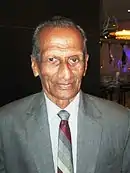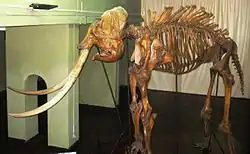Heiyantuduwa Raja (elephant)
Heiyantuduwa Raja (Sinhala:හෙයියන්තුඩුවේ රාජා)(1924-November 6 2002) was a Sri Lankan elephant, which carried the Relic of the tooth of the Buddha casket in the Dalada Perahera for 11 years after the demise of Maligawa Raja. Heiyantuduwa Raja's tusks were each 7 ft 6 in (2.3 m) in length when he was living and it was considered as one of the longest-tusked elephants in the country.[1]
 Historic Elephant | |
| Species | Sri Lankan elephant |
|---|---|
| Sex | Male |
| Born | 1924 Hambantota District, Sri Lanka |
| Died | 6 November 2002 (aged about 78) Kandy District, Sri Lanka |
| Resting place | National Museum of Colombo |
| Notable role | Main casket bearer of the Kandy Esala Perahera |
| Years active | 1945 – 2002 in captivity |
| Owner | William Gunasekara and Henry Gunasekara |
Owner


William Gunasekara with his
wife Eugine Gunasekara
He was captured from the Kattakaduwana jungle in Hambantota District. On 8 March 1945, the tusker had been public auctioned by then British Ceylon government at Hambantota Kachcheri and then William Gunasekara (also known as 'Heiyantuduwa Ralahami') of Heiyantuduwa in Biyagama had bought him for 10,500 Rupees . Gunasekara was a wealthy landed proprietor and owned fourteen elephants at that era. Later Heiyantuduwa Raja was owned by his youngest son Henry Gunasekara of Kandy.
Historic Elephant
Heiyantuduwe Raja participated at the Esala Perahera in Kandy for several years. After the demise of Maligawa Raja he also carried the casket of tooth relic for 11 years from 1989 to 2000 with permission from Neranjan Wijeyeratne, then Diyawadana Nilame of Sri Dalada Maligawa. To carry the casket of tooth relic was an opportunity bestowed upon only a few elephants in Sri Lanka. Heiyantuduwe Raja had also carried the main casket of Buddha's relics at the Kelaniya Duruthu Perahera, Bellanwila Perahera and Gangaramaya Navam Perahera in addition to the Sri Dalada casket.

National Museum, Colombo
.jpg.webp)
National Heritage
Heiyantuduwa Raja died on 6 November 2002; he was about 78 years old at the time of his death. Despite an offer of 120,000 U.S. Dollars by a Japanese company, Henry Gunasekara gave his skeleton to the Sri Lankan government in recognition of his part in the nation's heritage. Heiyantuduwa Raja's skeleton has been on display to the public at the National Museum of Colombo since 29 January 2013 [2]